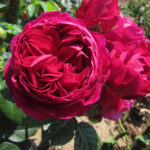Rose Claire Ocean (Clear Ocean)
One of the parameters that growers pay attention to when choosing plants for their flower garden is the productivity of the culture. Among the roses in this regard, the Claire Ocean variety (Clear ocean). In addition, it has a delightful appearance, mainly due to the delicate color of the flowers.

History and description of the variety
Rose Claire Ocean is a recent creation of German breeder Hans Jürgen Ewers. The variety was created in 2001. Its name is translated from English as "Clean Ocean". The perennial also has alternative names: Clear Oceans, Claire Ocean. The working name of this culture is TANaraelc.
A beautiful plant with a poetic name, once in your field of vision, cannot go unnoticed. All the "fault" of its beautiful flowers - white with creamy notes and a delicate peach core, goblet-shaped, large (up to 13 cm in diameter), consisting of delicate petals with wavy edges, the number of which in each bud reaches 55-60 pieces. In the phase of complete dissolution, their shade becomes even lighter, and the middle remains hidden from prying eyes. Being next to this charming flowering shrub, it is easy to feel a pleasant, unobtrusive, sweet aroma. Each flower retains its attractiveness and freshness on the bush from 10 days to two weeks. The flowering of a varietal plant is continuous throughout almost the entire growing season, up to the first autumn frosts, and is abundant.
The culture grows in height up to 100 - 120 cm.The width of the perennial crown varies from 0.6 to 0.8 m.The straight, even and rather strong stems of a lovely rose, painted in burgundy color at a young age, have an outfit of rich dark green foliage with a glossy shine. The bush does not fall apart, therefore it does not require support, and its stems do not need to be tied up even in the case of strong gusty winds, which is an indisputable advantage of this variety of roses. The plant's resistance to diseases is noted by experts as average, and winter hardiness as quite high. The double flowers of the tea hybrid do not rot and do not lose their shape due to rain, but they droop a little in the summer heat.

Growing and care
Our heroine has the greatest productivity, being planted in a warm, sunny place - flat or on a hill. Lowlands for planting a plant should be avoided, otherwise it will certainly get sick as a result of exposure to cold air masses. It is also recommended to choose a site for placing an ornamental shrub, taking into account its protection from drafts. The plant needs a soil that is drained, nutritious, with a pH ranging from 5.6 to 7.3. The depth of the planting pit must be made at least half a meter so that the roots of the culture are not cramped in it. After placing a layer of gravel or other drainage material on the bottom of the hole, add a part of the soil mixture prepared from leafy soil, manure, sand and peat (ratio of components 2: 3: 2: 1). It is better to plant a shrub in early May.
Like any plant from the hybrid tea group, the Claire Ocean variety is important to water, feed in a timely manner, and loosen and mulch the soil under it. To moisten the soil under the crop, use necessarily soft, not cold water. The watering procedure itself is carried out in the morning or evening hours up to 2 times a week. Top dressing time is early spring and mid-summer. In the first case, nitrogen fertilizers are used, in the second - complex fertilizers. The role of mulch will be played by mown grass or peat. During loosening near the plant, weeds are simultaneously removed.
The crop shows spring and autumn pruning. At the beginning of the period of sap flow, the shrub is eliminated from non-viable shoots, and in the fall, all perennial stems are shortened without exception. In the summer, do not forget to remove dried inflorescences in time to stimulate the formation of new buds.The plant is not damaged by frosts down to minus 23 ºС, so it can be left without shelter for the winter if you are cultivating the German beauty in the southern region. However, when growing a variety in the middle lane and, especially, in the northern regions, it must certainly be insulated. For this, agrospan or film is suitable. But first you should huddle the plant.
This rose cannot boast of an enviable immunity to disease, so it is necessary to provide it with repeated preventive treatment during the summer season. For this purpose, any suitable fungicide is used. However, spraying with an insecticide solution will also not hurt the culture - this measure will protect the beauty from the likely attacks of harmful insects.
Use cases
The white-cream rose Claire Ocean looks perfect in single and group plantings, especially against the backdrop of an emerald grass lawn. It can also be combined with tea hybrids of other varieties that have pink, scarlet, cherry, burgundy, purple, black, yellow or orange flowers. A wonderful combination of plants of the Germanic variety and evergreen crops - for example, thujas, junipers, fir, boxwood, dwarf mountain pines, dwarf forms of spruce. Snow-white flowers mixed with cream colors look very fresh on a dark green background of needles. Of the perennials, carnations, hosts, bells, clematis, delphinium, foxglove, irises, phloxes, primrose, sedum, rudbeckia, gelenium, geychera are suitable for the role of companions for our heroine. From annuals, choose verbena, pansies, heliotrope, forget-me-nots, lobelia.
The variety is suitable for cultivation in mixborders, ridges, in round classic flower beds. It can also be planted in the foreground of the site as an accent plant. Also, culture is placed near and in front of the gazebo, at the front entrance to the house, near the facade of the dwelling, along the fence. With the help of this decorative perennial, hedges are made out and the garden is divided into zones. Very cute compositions are obtained in which the tea hybrid is adjacent to decorative grains and herbs: miscanthus, fescue, single-color reed grass, granular pike, white onion, thyme, sage, lavender, parsley, tansy, oregano, salvia. Ground cover plants look spectacular next to flowering shrubs: lamb, bryozoan, styloid phlox, saxifrage, tenacious, highlander and loosestrife.
The beautiful flowers of the European beauty are used for cutting. They stand in water for an incredibly long time, up to 18 days, retaining their original freshness and shape.








